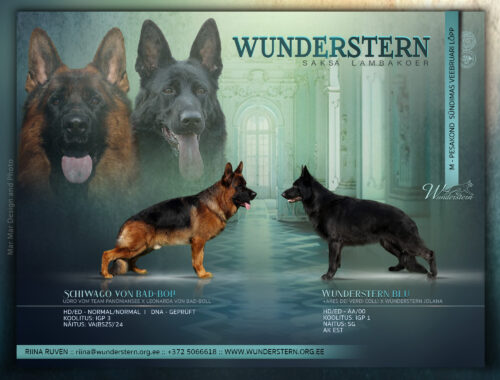27.12.2025 toimunud iseloomuhindamisel osalesid edukalt M-pesakonna koerad.
Hindajaks Monika Rusing
Õnnitleme
Wunderstern Morgan
Wunderstern Maya
Wunderstern Mara
Wunderstern Moona
ARTICUS kutsikanäitus
Featured
ESLÜ erinäitus Tagadil, kohtunik Patrick Send (SV)
Featured
VL1 Mbappe 6-9 kuud
VL3 Morgan 6-9 kuud
VL1 Mara 6-9 kuud
VL7 Maya 6-9 kuud
VL4 Moona 6-9 kuud
V2 VET SERT Nikkie veteranid
SG3 Havanda avaklass pk
SG3 Jorck 18-24 kuud
SG1 Kaya 18-24 kuud
SG3 Jackliin 18-24 kuud
V4 Ida kasutusklass pk
V3 Phoenix kasutusklass pk
V1 SERT Dhor kasutusklass
V5 Hondo kasutusklass
SG1 Drif kasutusklass
Kasvatajaklassis 1.koht

Balti Sieger 2025
Featured
Leedu peaerinäitus 2025
Featured
27.02.2025 sündis M-pesakond
Featured
L-pesakond sündinud
Featured
Kutsikad sündimas
Featured
Aretuskontroll 13.09.2024
Featured
K-pesakond sündis 02.03.2024
Featured
J-pesakond on sündinud
Featured
ARTICUS kutsikanäitus, TSB ja IGP-C võistlused
Featured
14.10.2023 ARTICUS kutsikanäitus, TSB ja IGP-C võistlused
Kohtunik Bernd Nagel (Saksamaa)
Varrukamehed Sten Lõhmus js Artjom Trefov
Veteranid emased
2. koht Wunderstern Yella
Kutsikad 4-6 kuud emased
VL1 Wunderstern Ida
Kutsikad 6-8 kuud isased
VL1 Wunderstern Halt
VL2 Wunderstern Hondo
VL3 Wunderstern Haaland
VL4 Wunderstern Gabriel
Kutsikad 6-8 kuud emased
VL1 Wunderstern Hemy
Kutsikad 6-8 kuud emased pikakarvalised
VL1 Wunderstern Havanda
Näituse parim kutsikas
4-6 kuud kutsikad
2-3.koht Wunderstern Ida
6-8 kuud kutsikad
1.koht Wunderstern Halt
2.koht Wunderstern Hemy
3.koht Wunderstern Havanda
TSB võistlus
Isased koerad
1.koht Wunderstern Bruno 5/4,5
2.koht Wunderstern Winston 4/4
3.koht Wunderstern Watson 3/4
Emased veteranid
1.koht Wunderstern Vera 4,5/4,5
Emased koerad
3.koht Wunderstern Thalissa 4/3,5
IGP-1 C-katse võistlus
1.koht Wunderstern Bruno 98 punkit
5.koht Wunderstern Verona 92 punkti
PALJU ÕNNE KÕIGILE!

Läti peaerinäitus 2023
Featured
23.-24.09 LÄTI peaerinäitus, kohtunik Marc Renaud (Prantsusmaa)
Veteranid
V2 Wunderstern Yella
4-6 kuud isased
VV 1 Wunderstern Hondo
VV4 Wunderstern Isaco
4-6 kuud pikakarvalised emased
VV1 Wunderstern Havanda
VV 7 Wunderstern Ida
18-24 kuud isased
SG2 Wunderstern Drif
SG3 Wunderstern Dhor
Kasutusklass
V8 Wunderstern Thalissa
Kutsikad aprillis 2023
Featured
ESLÜ peaerinäitus 2022
Featured
18.-19.06.2022 ESLÜ peaerinäitus Tagadil, kohtunik Nikolaus Mesler (SV)
4-6 kuud
VL1 Wunderster Dhor
VL8 Wunderstern Dess
veteranid
V2+Vet SERT Wunderstern Vera
avaklass
SG2 Wunderstern Webber
SG3 Wunderstern Phoenix
SG4 Wunbderstern Pippa
SG5 Wunderstern Penelope
18.-19.06 ESLÜ peaernäitus Tagadi, kohtunik Nikolaus Meßler (SV)
4-6 kuud
VL1 Wunderstern Dhor
VL8 Wunderstern Dess
Veteranid
V2+Vet SERT Wunderstern Vera
Avaklass
SG2 Wunderstern Webber
SG3 Wunderstern Phoenix
SG4 Wunderstern Pippa
SG5 Wunderstern Penelope
12-18 kuud
SG6 Wunderstern Bruno
SG8 Wunderstern Clif
SG3 Wunderstern Blu
SG8 Wunderstern Bayla
SG14 Wunderstern Cassandra
SG15 Wunderstern Cordelya
SG2+Jun SERT Wunderstern Cessylia
Kasutusklass
SG1 Wunderstern Scarlett
Parim emane varrukakoer Wunderstern Scarlett























